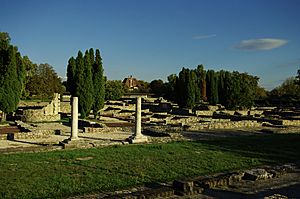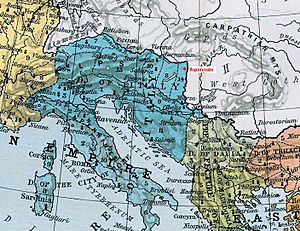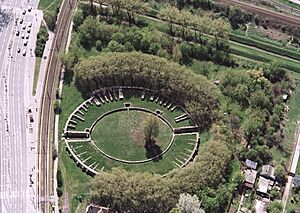Aquincum facts for kids

The ruins of Aquincum
|
|
| Location | Budapest (Óbuda district), Hungary |
|---|---|
| Region | Pannonia |
| Coordinates | 47°33′51″N 19°2′58″E / 47.56417°N 19.04944°E |
| Type | Settlement |
| History | |
| Founded | Approximately 41–54 |
| Periods | Roman Empire |
Aquincum was an ancient Roman city. It was located on the edge of the Roman Empire, in a province called Pannonia. Today, you can find its ruins in Budapest, the capital city of Hungary. Some people believe that the famous Roman emperor Marcus Aurelius wrote parts of his book Meditations while he was in Aquincum.
History of Aquincum
Aquincum was first settled by the Eravisci, a Celtic tribe. Later, it became an important military base for the Romans. This base was part of the Roman border defense system, known as the limes.
Around 41–54 AD, a group of 500 cavalry soldiers arrived. By 89 AD, a large Roman legion of 6,000 men was stationed there. The city slowly grew around this military fort.
In 103 AD, the Romans reorganized the province of Pannonia. Aquincum then became the capital city of Pannonia Inferior. It stayed the capital for over a hundred years. Under Emperor Hadrian, Aquincum became a proper city with its own government. Later, under Emperor Septimius Severus, it gained an even higher status as a Roman colonia.
Aquincum was a key place on the Roman frontier. It helped protect the empire from neighboring tribes like the Iazyges. Sometimes, Roman emperors would even set up their headquarters here.
By the end of the 2nd century, Aquincum had about 30,000 people. It covered a large part of what is now the Óbuda district in Budapest. You can still see Roman ruins in other parts of Budapest, like Contra-Aquincum. These Roman buildings were important for trade in the Pannonia province during the 2nd and 3rd centuries AD. Digs show us how people lived back then. Around the early 3rd century, Christianity began to spread in the city.
In the mid-4th century, Aquincum faced many attacks from the Sarmatian people from the north. As the Roman Empire began to decline, Aquincum was largely destroyed by 350 AD. Later, in 409 AD, Germanic tribes and the Huns invaded the area.
Buildings in the Settlement
People living in Aquincum enjoyed many advanced features of the Roman Empire. Their homes had central heating. They also had public baths, a temple for the god Mithras, and grand palaces.
The most important buildings in Aquincum are its two amphitheatres. These are the Aquincum Civil Amphitheatre and the Aquincum Military Amphitheatre. They were built in the 1st century AD. These were places where people watched exciting gladiatorial combat and fights between animals.
Aquincum Museum
Many historical items from Aquincum are now displayed in the Aquincum Museum. The museum shows how the city's water system worked. You can also see reconstructed Roman houses and beautiful paintings found at the site. The ruins of a three-level aqueduct have been found around the city. Many parts of it can still be seen today.
See also
 In Spanish: Aquincum para niños
In Spanish: Aquincum para niños




